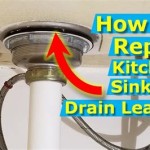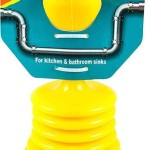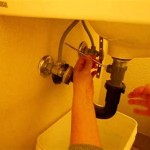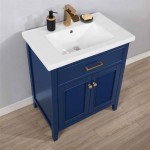Bathroom Sink Drains Slowly: The Aeration Connection
A slow-draining bathroom sink is a common household problem, often causing frustration and inconvenience. While many factors can contribute to this issue, a less-discussed but significant element is the role of air. Specifically, the absence of adequate air intake into the drain system can drastically impede water flow, resulting in the slow draining experienced by many homeowners. This article explores the relationship between air and drainage, identifies common causes for inadequate air intake in bathroom sink drains, and outlines potential solutions to restore proper draining function.
Understanding how a drain system functions is crucial to diagnosing a slow-draining sink. The typical bathroom sink drain system relies on gravity and pressure differentials to move water, soap residue, hair, and other debris through the pipes and ultimately into the main sewer line. Water naturally flows downhill due to gravity. However, as water flows down the drainpipe, it creates a partial vacuum behind it. This vacuum can impede further water flow unless it is relieved by air entering the drain system. Without proper air intake, the water struggles to move past the vacuum, resulting in a noticeable slow down and potential gurgling sounds.
The primary mechanism for allowing air into the drain system is through a vent pipe. This vent pipe, usually extending upwards through the roof of the house, provides a pathway for air to enter the plumbing system. As water flows down the drain, air is drawn in through the vent, equalizing the pressure and allowing the water to flow freely. When this venting system is compromised, the drain’s efficiency suffers.
Vent Pipe Blockages and Restrictions
One of the most frequent causes of inadequate air intake involves obstructions within the vent pipe itself. Over time, debris such as leaves, bird nests, small animal carcasses, or even accumulated ice can block the vent opening or the pipe's interior. This blockage restricts the flow of air into the drain system, creating a vacuum effect that inhibits water from draining quickly. Identifying and removing these blockages is essential to restoring proper drainage.
Visual inspection of the vent pipe opening on the roof is the first step in diagnosing this problem. Using binoculars can be helpful for a preliminary assessment from the ground. If debris is visible, safely accessing the roof is necessary for a closer examination and removal of the obstruction. It’s important to exercise caution when working on a roof, employing appropriate safety measures such as wearing non-slip shoes and using a secure ladder. A garden hose with a high-pressure nozzle can be used to flush out loose debris from the vent pipe. In more severe cases, a plumbing snake or auger may be required to break up and remove stubborn blockages deeper within the pipe.
Furthermore, the vent pipe might not be completely blocked but might have a partial restriction. This can occur due to a buildup of mineral deposits inside the pipe, particularly in areas with hard water. Over time, these deposits narrow the pipe's diameter, reducing the amount of air that can flow through it. Professional plumbing services may be necessary to address this type of restriction, as specialized equipment and techniques, such as hydro-jetting, are often required to effectively clean the pipe's interior.
In some instances, the vent pipe's design or installation may contribute to inadequate airflow. Improperly sized vent pipes, or those with excessive bends or dips, can restrict airflow even if they are not physically blocked. These design flaws can impede the system's ability to equalize pressure effectively. Correcting these issues often involves reconfiguring the vent pipe layout, which typically requires the expertise of a qualified plumber.
Clogged Sink Drain and P-Trap
While the vent pipe focuses on air intake, the drain itself, specifically the P-trap, is equally important for proper drainage. Even with a properly functioning vent system, a clogged sink drain or P-trap can directly impede water flow and inadvertently hinder air intake. The P-trap is the curved section of pipe located under the sink. Its primary function is to trap debris and prevent sewer gases from entering the home. However, it is also a common location for clogs to form.
Hair, soap scum, grease, and other materials tend to accumulate in the P-trap, gradually reducing the pipe's diameter and restricting water flow. As the clog grows, it can also prevent air from circulating freely within the drain system, exacerbating the slow-draining issue. Disassembling and cleaning the P-trap is often the first step in addressing a slow-draining sink. Place a bucket under the P-trap to catch any water, then carefully loosen the slip nuts connecting the P-trap to the drain pipes. Once the P-trap is removed, thoroughly clean it out, removing any accumulated debris. A small brush or a flexible plumbing snake can be used to dislodge stubborn clogs. Reassemble the P-trap securely, ensuring the slip nuts are properly tightened to prevent leaks.
Beyond the P-trap, the drainpipe extending from the sink basin can also become clogged. This section of pipe is often narrower than the P-trap and is susceptible to accumulating debris. Using a plumbing snake, carefully work it down the drainpipe to break up and remove any clogs. A plunger can also be used to create pressure and dislodge obstructions. Ensure there's enough water in the sink to cover the plunger cup for effective suction. Repeated plunging may be necessary to clear the clog completely.
Chemical drain cleaners are often marketed as a quick solution for clogged drains. However, these products should be used with caution. Harsh chemicals can damage pipes, particularly older metal pipes, and can also pose health risks if not handled properly. Moreover, chemical drain cleaners may not effectively dissolve all types of clogs, and can even worsen the problem by solidifying certain materials. When using chemical drain cleaners, always follow the manufacturer's instructions carefully and wear appropriate protective gear, such as gloves and eye protection. Consider using alternative methods, such as enzymatic drain cleaners, which are less harsh and more environmentally friendly. Alternatively, a mixture of baking soda and vinegar, followed by hot water, can sometimes effectively dissolve minor clogs.
Air Admittance Valves (AAVs): Potential Issues
In some bathroom plumbing systems, particularly in situations where a traditional vent pipe is difficult or impossible to install, an Air Admittance Valve (AAV), also known as a Studor vent, is used as an alternative venting mechanism. An AAV is a one-way valve that allows air to enter the drain system when negative pressure develops, but prevents sewer gases from escaping. When functioning correctly, an AAV provides adequate air intake, allowing water to drain freely.
However, an AAV can malfunction over time, leading to a slow-draining sink. The valve mechanism inside the AAV can become stuck or clogged with debris, preventing it from opening properly and allowing air to enter the drain system. When this occurs, the sink will drain slowly, similar to a situation with a blocked vent pipe. Diagnosing a faulty AAV involves visually inspecting the valve for any signs of damage or corrosion. Listen for a hissing sound when water drains, which can indicate that the valve is not sealing properly. In some cases, gently tapping the AAV may dislodge any debris and restore its function. However, if the AAV is clearly damaged or malfunctioning, it should be replaced.
Replacing an AAV is typically a straightforward task that can be performed by a homeowner with basic plumbing skills. The AAV is usually threaded onto a pipe fitting, making it easy to unscrew and replace. Ensure the new AAV is properly sized and compatible with the existing plumbing system. Follow the manufacturer's instructions for installation and tighten the connections securely to prevent leaks. Regular inspection and maintenance of AAVs can help prevent malfunctions and ensure proper drainage.
Furthermore, the placement of the AAV is crucial for its optimal performance. AAVs should be installed in an accessible location, preferably above the flood rim of the sink. This allows for easy inspection and replacement if necessary. They should also be installed in a location that is protected from extreme temperatures and direct sunlight, which can damage the valve mechanism. Incorrectly installed AAVs may not function properly and can contribute to slow-draining sinks and sewer gas odors.

How You Can Fix A Slow Draining Drain On Your Own Call Ashton Plumbing

Slow Sink Drain 6 Diy Fixes For Before You Call A Plumber Bob Vila

4 Tips To Fix A Slow Draining Sink

Slow Sink Drain 6 Diy Fixes For Before You Call A Plumber Bob Vila

How To Clear A Clogged Drain Reviews By Wirecutter

5 Natural Ways To Unclog A Bathroom Sink Hiller How

5 Things To Try If You Have A Noisy Shower Or Bathroom Sink Drain

6 Ways To Fix Clogged Drains Keep Pipes Flowing Freely Horizon Services

How To Unclog A Bathroom Sink The Home

Why Is My Sink Not Draining All You Need To Know Checkatrade







